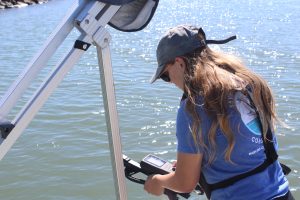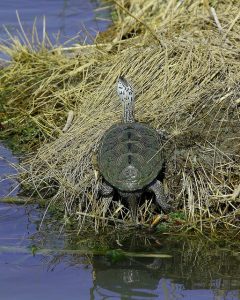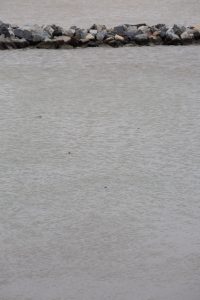By Jack Chavez, Staff Writer

Environmental scientist Carly Toulan uses a YSI ProDSS meter to gauge water temperature and salinity in Marsh Harbor on Monday. Toulan says that while salinity isn’t part of the survey, it does tell them how salty water the water in a given area. Being so close to the inlet, the salinity in the harbor was around 29 parts per thousand, which she said, is pretty salty for brackish water. JACK CHAVEZ/BAYSIDE GAZETTE
The humidity was low, the temperature hovered around 70 degrees, there wasn’t a cloud in the sky and the mosquitos and flies were inexplicably — miraculously — absent in West Ocean City’s Marsh Harbor on Monday morning.
The conditions were good for some good old-fashioned turtle counting.
Every June, the Maryland Coastal Bays Program facilitates a northern diamondback terrapin survey over land and water. The surveys typically last 12 days. This year, it began on May 31 and will conclude Jun 11.
“They’re the only brackish water turtle in the United States and we’re trying to get an idea of the population density in the coastal bays,” said Roman Jesien, science and restoration coordinator MBCP. “We have a number of sites we do these surveys on and over time that will build up a database of where the turtles are and how many we see. We’ve got some areas that we do see turtles so we’ll monitor those and try to learn a little bit more about what makes certain areas better for turtles than other areas. Right now we’re at a loss.”
Jesian pointed out that in Marsh Harbor, there’s not exactly an abundance of sandy beaches, which are ideal for nesting.

PHOTO COURTESY MARYLAND COASTAL BAYS PROGRAM
“And yet, they’re here,” he said, noting the several turtles he and the rest of the team — environmental scientist Carly Toulan and intern Sara Butz — logged.
When it comes to counting the turtles themselves, Toulan said it can be a challenge for the newcomer, but surveyors tend to pick up the common tips and tricks quickly.
“Females are typically larger (than males),” Toulan said. “They have much larger, fatter heads, whereas males are a lot smaller. If you’re unsure, you just (note) ‘undetermined.’ The data sheet (we hand out to surveyors) gives you adult female, adult male-slash-juvenile, then you have undetermined. Sometimes it can be really hard when you’re looking and you just see a head pop up for barely a second and it’s way (further down from where you are). But once you see a terrapin head, you remember what it looks like. It’s easy to point them out from there on.”
“But especially females — they’re easier to identify because of their big, fat heads.”
The diet of the diamondback terrapin consists of snails, crabs, fish and anything that’s dead, which may explain their congregation in areas like Marsh Harbor — perhaps it’s just a food stop, Jesien said.
Weather can have an effect on a survey, which is why the project is extended over more than a week. The conditions were good on Monday, but the hotter days are always good. Toulan said. The hotter it is, the more likely to see turtles active in the water or sunbathing on the shores. Low tide is also a prime survey time.

Northern diamondback terrapins can look like sticks floating above the surface while in the water. PHOTO COURTESY ZACH GARMOE
Toulan said that MCBP implements some safeguards to make sure that turtles aren’t double-counted. For instance, they encourage survey groups to limit how many people are actually counting. On a trip like up Marsh Harbor where eventually the watercraft must turn around, the program asks surveyors to only county one way. But if surveyors are counting in the same or close-by areas, they’re advised to wait a certain amount of time first.
Ultimately, the terrapin survey allows MCBP to monitor what the terrapin population is doing, assess the health of the ecosystem and formulate plans for action, if necessary.
“It’s always important for people to realize these surveys are happening in their watershed because these species are significant not only ecologically but also, sometimes it’s cultural, sometimes it’s economics, even for environmental health,” Toulan said. “There are different reasons why we do these surveys.”
This story appears in the print version of the Bayside Gazette on June 9, 2022.
